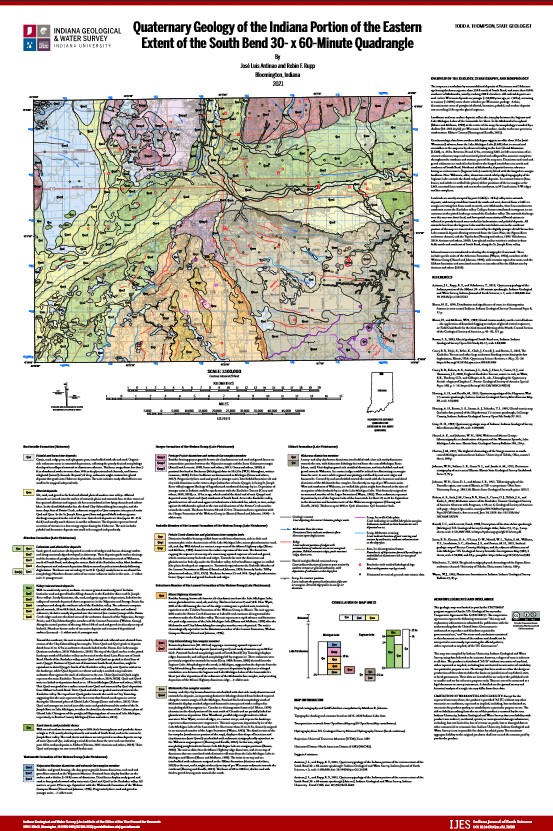Quaternary Geology of the Indiana Portion of the Eastern Extent of the South Bend 30- x 60-Minute Quadrangle
Main Article Content
Abstract
The Quaternary Geology of the eastern South Bend 30- x 60-Minute Quadrangle in Indiana represents landforms and near-surface sediments deposited during the Wisconsin Episode, Late Pleistocene. Sediments and landforms reflect the interplay between the Saginaw and Michigan Lobes of the Laurentide Ice Sheet. A relatively shallow, buried pre-Wisconsin and mid-Wisconsin morphology has been overridden by advances leading to the Last Glacial Maximum (LGM), ca. 24 ka. Between 24 and 17 ka, retreating ice fronts from the Michigan Lobe left a succession of ice-contact sediment ramps and associated pitted and collapsed fan-moraine complexes throughout the south and west of the map area. A sequence of stacked diamicton and sand and gravel fan heads appears at the hinged interlobate area north and northeast of South Bend. Ice margin positions are marked by distinct features like fans, kames and ice-walled lake plains, which are well developed on Michigan Lobe margins. The thicker glaciofluvial sand and gravel packages appear mostly interbedded with diamicton beds along fan heads, with relatively minor deposits in valley train units. Lowlands are mostly occupied by post-LGM (ca. 18 ka) valley-train outwash deposits, with interpreted flow toward the south and west, derived from an ice margin retreating first from south to north, near Mishawaka, then from southeast to northwest across the Kankakee valley. Sand and gravel colluvial and alluvial fans developed in a short span after ice retreated, along with incision of the ice-sculpted morphology. Late-glacial aeolian sand dunes sealed the landscape. Relatively minor modification of the landscape during the Holocene is indicated by alluvial and palustrine deposits.
Downloads
Article Details
All content for Indiana Journal of Earth Sciences is licensed under a Creative Commons Attribution-NonCommercial 4.0 International License (CC BY-NC 4.0; http://creativecommons.org/licenses/by-nc/4.0/), wherein the author retains copyright. As a service to the research community and as an outlet of its public mission, the IGWS commitment to true open access to scholarly information extends to authors, thus the Indiana Journal of Earth Sciences content is archived at the IGWS and the IU Open Scholar Works Archive.
